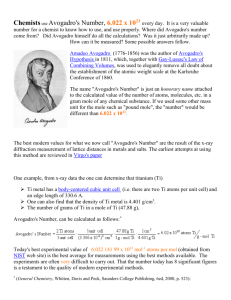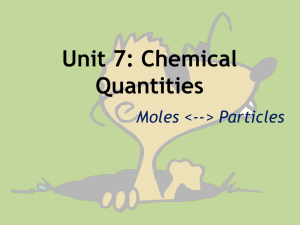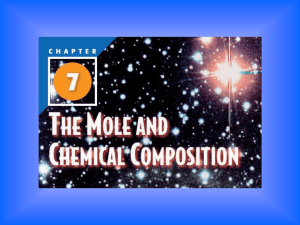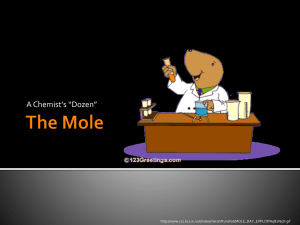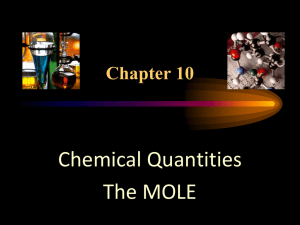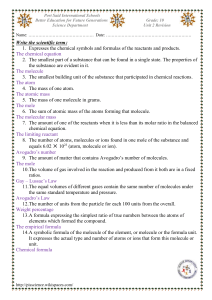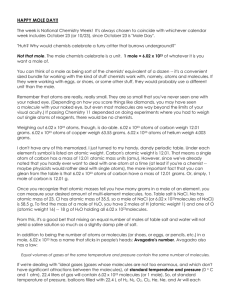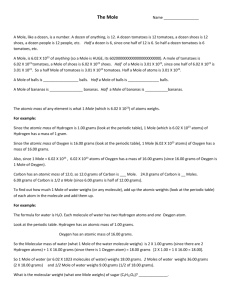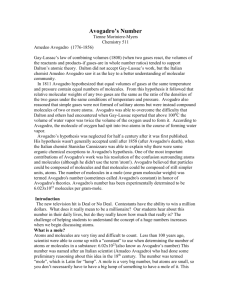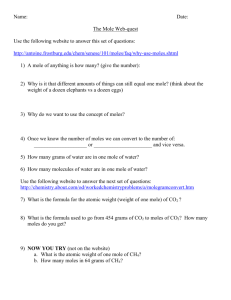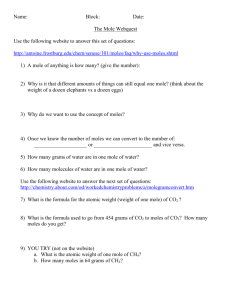ChR3d - Leek High School
advertisement
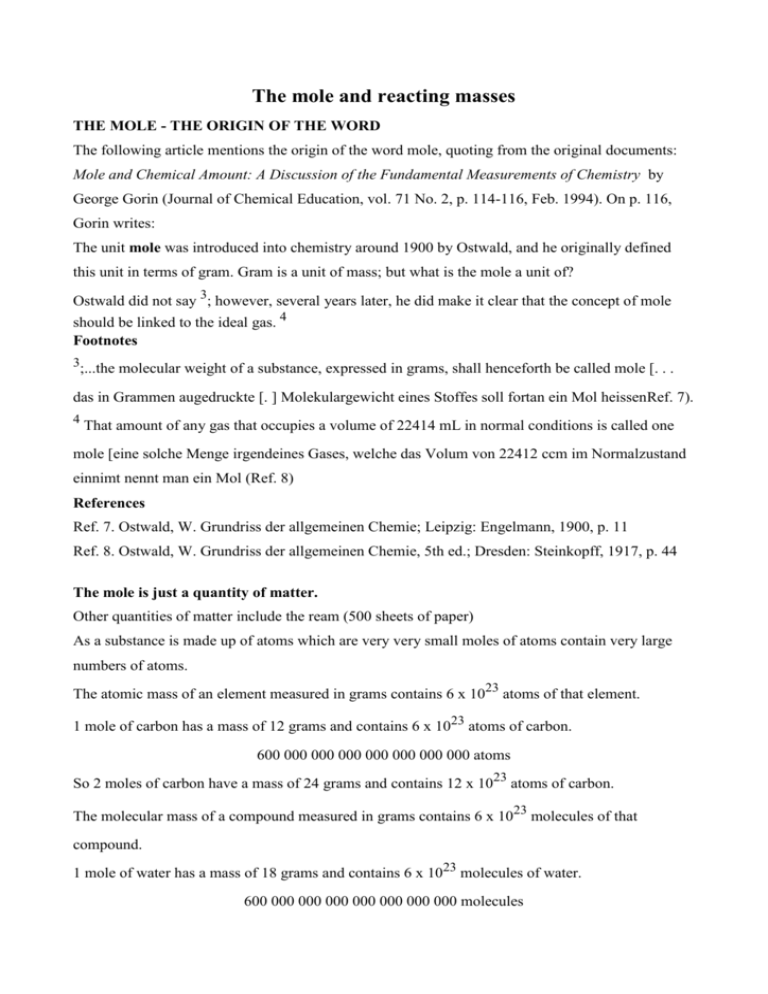
The mole and reacting masses THE MOLE - THE ORIGIN OF THE WORD The following article mentions the origin of the word mole, quoting from the original documents: Mole and Chemical Amount: A Discussion of the Fundamental Measurements of Chemistry by George Gorin (Journal of Chemical Education, vol. 71 No. 2, p. 114-116, Feb. 1994). On p. 116, Gorin writes: The unit mole was introduced into chemistry around 1900 by Ostwald, and he originally defined this unit in terms of gram. Gram is a unit of mass; but what is the mole a unit of? Ostwald did not say 3; however, several years later, he did make it clear that the concept of mole should be linked to the ideal gas. 4 Footnotes 3 ;...the molecular weight of a substance, expressed in grams, shall henceforth be called mole [. . . das in Grammen augedruckte [. ] Molekulargewicht eines Stoffes soll fortan ein Mol heissenRef. 7). 4 That amount of any gas that occupies a volume of 22414 mL in normal conditions is called one mole [eine solche Menge irgendeines Gases, welche das Volum von 22412 ccm im Normalzustand einnimt nennt man ein Mol (Ref. 8) References Ref. 7. Ostwald, W. Grundriss der allgemeinen Chemie; Leipzig: Engelmann, 1900, p. 11 Ref. 8. Ostwald, W. Grundriss der allgemeinen Chemie, 5th ed.; Dresden: Steinkopff, 1917, p. 44 The mole is just a quantity of matter. Other quantities of matter include the ream (500 sheets of paper) As a substance is made up of atoms which are very very small moles of atoms contain very large numbers of atoms. The atomic mass of an element measured in grams contains 6 x 1023 atoms of that element. 1 mole of carbon has a mass of 12 grams and contains 6 x 1023 atoms of carbon. 600 000 000 000 000 000 000 000 atoms So 2 moles of carbon have a mass of 24 grams and contains 12 x 1023 atoms of carbon. The molecular mass of a compound measured in grams contains 6 x 1023 molecules of that compound. 1 mole of water has a mass of 18 grams and contains 6 x 1023 molecules of water. 600 000 000 000 000 000 000 000 molecules How big is this number 6 x 10 23 ? Avogado's Number is so large many students have trouble comprehending its size. 1) Avogadro's Number compared to the number of grains of sand in the Sahara desert. Imagine counting the number of grains of sand in the Sahara desert: The answer is around 1024 plus or minus a few. If we had Avogadro's number of grains of sand like those on a beach, we would have enough sand to cover the entire state of California, and the pile of sand would be as high as a ten-story building. 2) Avogadro's Number compared to the population of the Earth. Assume the population of the earth to be six billion (6 x 109 people). We compare to Avogadro's Number like this: 6.022 x 1023 divided by 6 x 109 = approx. 1 x 1014 In other words, it would take about 100 trillion Earth populations before we get Avogadro's number. 3) Avogadro's Number as a Balancing Act. At the very moment of the Big Bang, you began putting hydrogen atoms on a balance and now, 19 billion years later, the balance has reached 1.008 grams. Since you know this to be Avogadro Number of atoms, you stop and decide to calculate how many atoms per second you had to have placed. 1.9 x 1010 yrs x 365.25 days/yr x 24 hrs/day x 3600 sec/hr = 6.0 x 1017 seconds to reach one mole 6.022 x 1023 atoms / mole divided by 6.0 x 1017 seconds/mole = approx. 1 x 106 atoms/second So, after placing one million hydrogen atoms on a balance every second for 19 billion years, you get Avogadro Number of hydrogen atoms (approximately). 4) Avogadro Number of Coins If Avogadro's number of pennies were distributed equally to every man, woman, and child on earth (currently about six billion), each person would be able to spend one million pounds an hour, 24 hours of every day, and he or she would die before spending all of the money. Where does this number 6 x 10 23 come from ? For a more detailed explanation COMPOUNDS and MOLES - PROBLEMS NOTE This quiz is for your own use only. Answer the questions below. 1. Calculate the mass of 1 mole of the following - circle one of the following answer (Atomic masses C = 12, H = 1, O = 16, Na = 23, N = 14, Ca = 40, Mg = 24, Cu = 64)) a) Methane b). Calcium CH4 CaCO3 52g 48g 16g 13g 5g 100g 55g 220g 2400g 68g 50g 48g 129g 98g 7g 41g 58g 42g 82g 3g 8g 23g 46g 137g 45g 96g 2g 80g 32g 128g 102g 150g 164g 9g 116g 5g 53g 209g 85g 69g 120g 170g 89g 180g 24g carbonate c). Sulphuric acid d). Magnesium Hydroxide e). Ethanol f). Copper H2SO4 Mg(OH)2 C2H5OH CuS sulphide g). Calcium nitrate h). Sodium nitrate i). Sugar Ca(NO3)2 NaNO3 C6(H2O)6 2. What is the mass of 2 moles of sulphur trioxide SO3? 70g 8g 160g 96g 128g 288g
